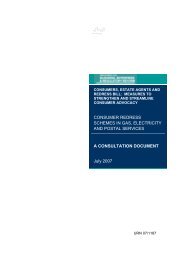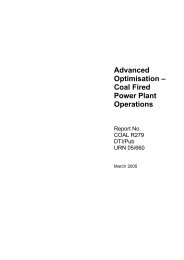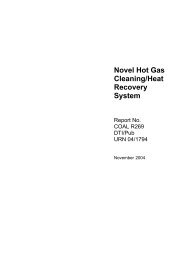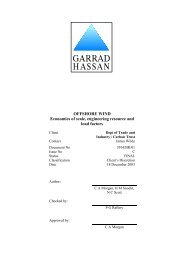(70) Therefore, the risk of sulphuric acid dew point attack ... - DTI Home
(70) Therefore, the risk of sulphuric acid dew point attack ... - DTI Home
(70) Therefore, the risk of sulphuric acid dew point attack ... - DTI Home
Create successful ePaper yourself
Turn your PDF publications into a flip-book with our unique Google optimized e-Paper software.
<strong>of</strong> biomass fuels and <strong>the</strong> land area and fuel supply infrastructure required to<br />
support even a relatively small plant.<br />
There are a variety <strong>of</strong> approaches to biomass gasification including fixed bed,<br />
rotary kiln, pressurised circulating fluidised bed (CFB), atmospheric CFB and<br />
<strong>the</strong> Batelle process [72] . The air blown CFB, fixed bed and rotary kiln<br />
approaches produce a low calorific value (typically 5-6MJNm -3 ) ‘syngas’<br />
while <strong>the</strong> Batelle process by excluding air and using steam as <strong>the</strong> gasifying<br />
medium produces a medium calorific value gas (~15 MJNm -3 ). The ‘syngas’<br />
from all <strong>of</strong> <strong>the</strong>se processes can be burnt in a GT or a reciprocating engine with<br />
exhaust heat recovery. If syngas is to be burnt in an engine, it must be cleaned<br />
first to remove particulates and in some cases ‘tars’ as well. Current gas clean<br />
up technology requires that <strong>the</strong> gas be cooled from <strong>the</strong> gasification<br />
temperature (typically 850 - 950°C) before filtration. There are <strong>the</strong>refore two<br />
HRSGs in <strong>the</strong> system, one to recover heat from <strong>the</strong> hot process gas prior to<br />
filtering and <strong>the</strong> second to recover heat from <strong>the</strong> engine exhaust. The ‘syngas’<br />
cooler HRSG will be exposed to carry over <strong>of</strong> bed material and ash. Biomass<br />
fuels may be rich in alkali metals which increase <strong>the</strong> potential for tube fouling.<br />
This needs to be taken into account in <strong>the</strong> design.<br />
Very few BIG-CC projects have yet been successfully developed. If BIG-CC<br />
technology can be made to operate reliably and economically it will open up a<br />
new market for industrial scale HRSGs.<br />
4.4.3 Microturbines<br />
In general, microturbines are unlikely to be coupled with HRSGs. The<br />
relatively low exhaust temperature (if recuperated as most are) and flow are<br />
not normally sufficient for economic steam generation at useful steam<br />
conditions. However, microturbine suppliers are working on scaling up <strong>the</strong>ir<br />
units. Bowman Power Systems expect to release a 200kWe unit soon and<br />
believe that microturbines up to 500kWe are feasible. At <strong>the</strong> larger sizes <strong>the</strong>y<br />
are more likely to be coupled to HRSGs to provide steam flows for smaller<br />
consumers in some specialist applications. It is possible that <strong>the</strong>y could be<br />
used for air pre-heating or provide heat for an LP circuit as part <strong>of</strong> a larger<br />
boiler system.<br />
4.5 Conclusions<br />
• Future increases in HRSG operating conditions will largely be dictated by<br />
increases in GT exhaust temperature.<br />
• One area <strong>of</strong> significant interest is once through design. The main benefit <strong>of</strong><br />
this technology at present is its suitability for flexible operation. In <strong>the</strong><br />
long-term future, it should pave <strong>the</strong> way for supercritical cycles with even<br />
higher <strong>the</strong>rmal efficiencies.<br />
• Ano<strong>the</strong>r area <strong>of</strong> significant interest is <strong>the</strong> use <strong>of</strong> HRSG steam for GT blade<br />
cooling in <strong>the</strong> latest class <strong>of</strong> GTs. This presents significant challenges for<br />
HRSG design in attaining <strong>the</strong> high steam qualities required.<br />
(96)
















